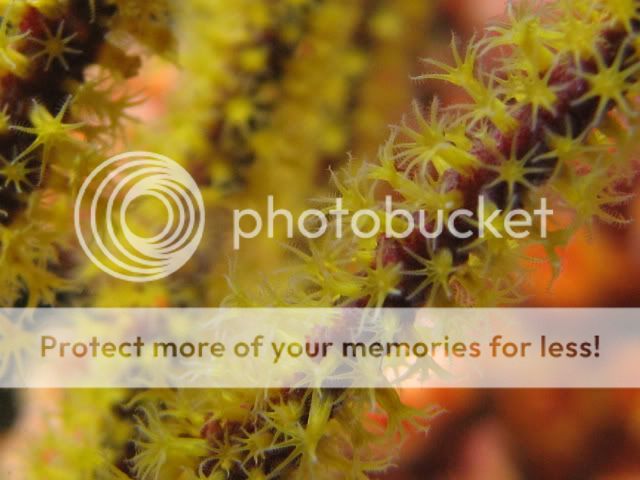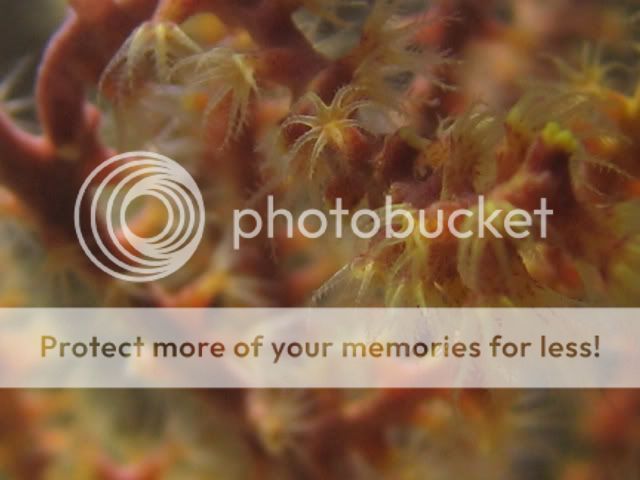You are using an out of date browser. It may not display this or other websites correctly.
You should upgrade or use an alternative browser.
You should upgrade or use an alternative browser.
Let's talk about corals to stock in a non-photosynthetic aquarium
- Thread starter Aquabacs
- Start date
Aquabacs
New member

Menella sp.
Common names: Menella Gorgonian, Golden Sea Rod
Note: coral also comes in blue and brown variations Blue Sea Rod
Type of Coral: Gorgonian
Care Level: Intermediate
Reproduction: most likely sexual, can be fragged
Coral Placement/Orientation: Insensitive to light. Coral in not finicky in placement, does well in laminar flow or turbulent flow, can be glued or epoxied vertically or horizontally
Feeding: Gorgonians are suspension feeders that filter small food particles from the water column: zooplankton, eggs/larvae, possibly bacterioplankton and detritus. Food should be no larger than frozen cyclop-eeze, with the majority being much smaller such as rotifers. Polyps will retract without constant food in the water.
Additional tips or words of wisdom This large polyp species of gorgonian is one of the more easier species of non-photosynthetic gorgonians to keep. They are still difficult relative to most photosynthetic corals and should be attempted once Beginner non-photosynthetic corals have been able to be sustained in the aquarium for a period of time. You should feed small amounts as often as possible. A continuous feeding system (dry or liquid) will yield the best results as the polyps should stay open almost 24/7. If the polyps stay closed most of the time, either you don't have enough flow, enough food in the water or your water quality is too poor. This coral will grow vertically from the tips and "encrust" from the base if it is healthy. It will grow in the direction of the strongest flow and can handle literally being blasted with it. The tissue gets algae and detritus build up easily and should be kept clean (high flow will help a lot).
Note: Coral can "wax over" and shed. While this process is occurring, polyps will not expand. The process can be assisted by using a turkey baster to gently remove the "waxed over" coating. Coral will have a "new" appearance after this takes place.
Aquabacs
New member

Astrogorgia sp.
Common names: Astrogorgia Sea Fan, Astro Sea Fan
Type of Coral: Gorgonian
Care Level: Advanced
Reproduction: most likely sexual, can be fragged
Coral Placement/Orientation: Insensitive to light. Coral in not finicky in placement, does well in laminar flow or turbulent flow, can be glued or epoxied vertically or horizontally
Feeding: Gorgonians are suspension feeders that filter small food particles from the water column: zooplankton, eggs/larvae, possibly bacterioplankton and detritus. Food should be no larger than frozen cyclop-eeze, with the majority being much smaller such as rotifers. Polyps will retract without constant food in the water.
Additional tips or words of wisdom This non-photosynthetic gorgonian is one of the more difficult species to keep. Should be attempted once Intermediate non-photosynthetic gorgonians have been able to be sustained in the aquarium for a period of time. You should feed small amounts as often as possible. A continuous feeding system (dry or liquid) will yield the best results as the polyps should stay open almost 24/7. If the polyps stay closed most of the time, either you don't have enough flow, enough food in the water or your water quality is too poor. This coral will grow vertically from the tips and "encrust" from the base if it is healthy. It will grow in the direction of the strongest flow and can handle literally being blasted with it. The tissue gets algae and detritus build up easily and should be kept clean (high flow will help a lot).
Note: Coral can "wax over" and shed. While this process is occurring, polyps will not expand. The process can be assisted by using a turkey baster to gently remove the "waxed over" coating. Coral will have a "new" appearance after this takes place.
Timeless1483
In Memoriam
Ptilosarcus gurneyi

Common Name: Sea Pen
Type of coral: Octocorals, soft coral, Sea whip family.
Care: Advanced
Coral Placement: Bottom, no light requirements, place in substrate-root like structure.
Feeding:Filter feeder. Phytoplakton, zooplakton, ect.
Additional info: sea pens are colonial animals with multiple polyps ,a sea pen's polyps are specialized to specific functions. Normally found in 10+ m deep waters, low flow areas.Their primary predators are nudibranchs and sea stars, some of which feed exclusively on sea pens. When touched, sea pens emit a bright greenish light; this is known as bioluminescence.

Common Name: Sea Pen
Type of coral: Octocorals, soft coral, Sea whip family.
Care: Advanced
Coral Placement: Bottom, no light requirements, place in substrate-root like structure.
Feeding:Filter feeder. Phytoplakton, zooplakton, ect.
Additional info: sea pens are colonial animals with multiple polyps ,a sea pen's polyps are specialized to specific functions. Normally found in 10+ m deep waters, low flow areas.Their primary predators are nudibranchs and sea stars, some of which feed exclusively on sea pens. When touched, sea pens emit a bright greenish light; this is known as bioluminescence.
Wow never seen one of those in an aquarium before!
I've sold plenty while in wholesale and attempted a couple myself. They perished, probably starved to death. I do know one LFS that had "success" with them, if you can call 6 months a success.
Now those were tropical species and not the temperate Ptilosarcus gurneyi posted above (ranges from Alaska to Baja). Not sure if a temperate species has a place in this forum though
Aquabacs
New member
ChadTheSpike
Reef Engineer
You all are doing a really excellent job to educate and learn about azoo corals. Great job and great thread to all you guys!
biloulou
New member
You all are doing a really excellent job to educate and learn about azoo corals. Great job and great thread to all you guys!
+1. :thumbsup::thumbsup:
dainiusiva
New member
you are doing a great job,educating the comunity,thumbs up!
Help with spider sponge
Help with spider sponge
Has anyone ever posted info on caring for spider sponges... i had a really nice one that did well untill cyano choked it out, I have a few frags and the original 3 inch long stub... i cut the entire branches off... it was about 13 inches tall with several branches. I have the cyano under control now that my ATS has kicked in full force... if anyone could point me towards more info i would really appreciate \
thanks
brandon
Help with spider sponge
Has anyone ever posted info on caring for spider sponges... i had a really nice one that did well untill cyano choked it out, I have a few frags and the original 3 inch long stub... i cut the entire branches off... it was about 13 inches tall with several branches. I have the cyano under control now that my ATS has kicked in full force... if anyone could point me towards more info i would really appreciate \
thanks
brandon
SKremk
Member

- Haliclona sp.
- Blue Sponge
- Sponge
- Care Level: Intermediate
- Not sure how it reproduces but it can be fragged easily. Frags of the sponge readily attaches themselves to new locations within a few days.
- Coral Placement/Orientation: Anywhere with medium to strong flow. Direct light does not seem to bother the sponge.
- Feeding: filter feeder. I don't directly feed ths sponge, but I do continuously drip a variety of plankton foods.
- Notes: This sponge adds great color to any tank, and seems to be fairly hardy. Julian Sprung's Invertebrates reference guide says they live in direct sunlight in the wild. In my tank, I have some frags that are in shaded areas that do fine. A few small pieces also get exposed to air during water changes and don't seem to mind.
Similar threads
- Replies
- 0
- Views
- 558
- Replies
- 0
- Views
- 265
- Replies
- 0
- Views
- 237
- Replies
- 0
- Views
- 827
